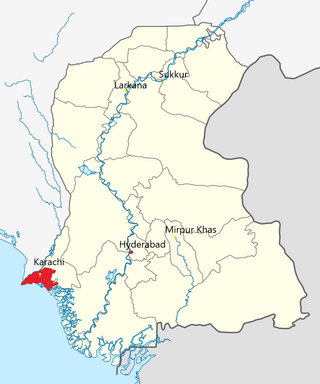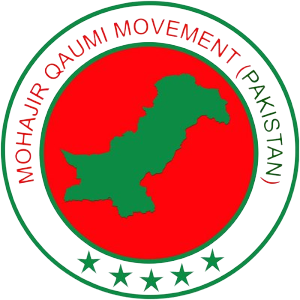
Hyderabad is a city and the capital of Hyderabad Division in the Sindh province of Pakistan. It is the second-largest city in Sindh, and the fifth largest in Pakistan.

The Muttahida Qaumi Movement (MQM), previously known as Muhajir Qaumi Movement, is a secular political party in Pakistan that was founded by Altaf Hussain in 1984. Currently the party is split between 2 main factions. MQM-London faction is controlled by Altaf Hussain from London, while MQM-Pakistan is run by Khalid Maqbool Siddiqui based in Pakistan. Its electoral symbol was a kite.

Altaf Hussain is a British Pakistani politician who is known as the founder of the Muttahida Qaumi Movement. He holds United Kingdom citizenship and has been living in exile in the UK since the start of Operation Clean-up. Since 2015, he has been a fugitive from the Anti Terrorism Court of Pakistan on the charges of murder, targeted killing, treason, inciting violence and hate speech. He went on trial in the UK in January 2022 for promoting terrorism and unrest through hate speech in Pakistan, and was acquitted the next month. He had fled the country in 1992 after a crackdown against his party was launched.

The All Pakistan Muttahida Students Organization is a Pakistani student organization notable for creating a political party: the Muhajir Quami Movement, now called the Muttahida Qaumi Movement (MQM).

Operation Clean-up, also known as Operation Blue Fox, was an armed military intelligence program led by the Sindh Police and Pakistan Rangers, with an additional assistance from the Pakistan Army and its related intelligence agencies. Planned by the FIA, Intelligence Bureau and launched the directives of Prime Minister Nawaz Sharif in 1992, the program was more strictly pursued by upcoming Prime Minister Benazir Bhutto in 1993–94, as part of her internal policies.

Jinnahpur refers to an alleged plot in Pakistan to form a breakaway autonomous state to serve as a homeland for the Muhajir people.

The Mohajir Qaumi Movement Pakistan also known as Mohajir Qaumi Movement (Haqiqi), MQM-Haqiqi is a political party claiming to represent the Mohajir in Sindh, Pakistan whose leader is Afaq Ahmed.

The Muhajir people are Muslim immigrants of various ethnic groups and regional origins, and their descendants, who migrated from various regions of India after the Partition of India to settle in the newly independent state of Pakistan. The community includes those immigrants' descendants, most of whom are settled in Karachi and other parts of urban Sindh. The Muhajir community also includes stranded Pakistanis in Bangladesh who migrated to Pakistan after 1971 following the secession of East Pakistan in the Bangladesh Liberation War.
The 2010 Karachi riots started on August 3, 2010, after the assassination of Parliament member Raza Haider, a member of the Muttahida Qaumi Movement political party, on the night of August 2, 2010, in Karachi, Pakistan. The Muttahida Qaumi Movement (MQM) represents the Urdu-speaking Muhajir and is a political rival of the Pashtuns who have migrated to the city from northwest Pakistan. Haider, a Shia Muslim, was killed as he attended a funeral at a mosque.
The Qasba–Aligarh massacre was an ethnic massacre that took place when recently settled armed tribal Pashtuns from KPK, Pakistan and Afghanistan attacked densely populated civilized locals in Qasba Colony, Aligarh Colony and Sector 1-D of Orangi in Karachi in the early hours of the morning on 14 December 1986. According to official reports, around 49 people were killed and several hundred were injured in what was perceived as a "revenge killing" by newly settled armed Pashtuns following an unsuccessful raid on a Pashtun heroin processing and distribution center in Sohrab Goth by the security forces. Most of the residents of the two colonies happened to be Muhajirs like Biharis who had been freshly repatriated from Bangladesh.
Bushra Zaidi was a 20-year-old girl whose death in a traffic accident on April 15, 1985 started riots in Karachi, Sindh, Pakistan. Bushra, a 20-year-old Muhajir student of Sir Syed College, died after being struck by a bus driver. It was thought at the time that the driver was Pashtun.
On September 30, 1988, hundreds of people, mostly Muhajirs, were killed in Hyderabad, Sindh in what was known as "Black Friday". The death toll was above 250, and the attacks are said to have been coordinated and carried out by Sindhi nationalist militants. Unidentified gunmen opened fire on large crowds of innocent bystanders, including women and children, in Latifabad. The MQM accused Qadir Magsi and nationalists carrying out the attack.
1972 Language violence in Sindh occurred starting on 7 July 1972 when the Sindh Assembly passed The Sindhi Teaching, Promotion and Use of Sindhi Language Bill, 1972 which established Sindhi language as the sole official language of the province resulting in language violence in Sindh.
The Sindh Mohajir Punjabi Pathan Muttahida Mahaz was a political party in the Pakistani province Sindh. The party was founded in 1969. Nawab Muzaffar Khan was the convenor of MPPM. In theory the party sought to serve as a political platform for Muhajirs, Pashtuns and Punjabis in Sindh, but in reality it functioned as a Muhajir political party as the Pashtun and Punjabi presence in the MPPM ranks was very limited. The party mobilized Urdu-speaking Muhajirs against the emerging Sindhi nationalist movement. It was led by Muhajir bureaucrats and businessmen. The main base of the MPPM was the city of Hyderabad.

The Insurgency in Sindh is a low-intensity insurgency waged by Sindhi Nationalists against the government of Pakistan. Sindhi nationalists want to create an independent state called Sindhudesh. However, this movement never gained support from the populace of urban Sindh.
Persecution of Muhajirs or Human rights abuses against Muhajirs or Anti-Muhajir sentiment ranges from discrimination, mass killings, forced disappearances and torture, to political repression and suppression of freedom of speech of Muhajirs, mainly those belonging to the right wing party Muttahida Qaumi Movement – Pakistan.

The Muhajir Province Movement is a proposed province movement in the Pakistani province of Sindh. This movement is backed by a Muhajir pan-nationalist political and ethnic movement seeking to establish a separate province in Sindh which seeks to represent the Muhajir people of Pakistan. It is proposed to consist of Muhajir-majority areas of Sindh which would be independent from Sindh government.
Pucca Qila Massacre was a coordinated massacre of Muhajir civilians conducted by Sindh police on the orders of the PPP-led Sindh Government. The massacre resulted in the deaths of more than 162 Muhajirs. The massacre resulted in the dismissal of the Benazir Bhutto government by President Ghulam Ishaq Khan, allegedly on the orders of Pakistan army.
MQM Militancy refers to militancy in Pakistan associated with the Muttahida Qaumi Movement party.
Second MQM insurrection refers to an insurrection by MQM, a political and militant organisation representing muhajir people which launched an insurrection in 1978 against Sindh government as well as multiple other opponents.This insurrection was suppressed by Pakistan army in the Operation Cleanup. In 1994 after military's withdrawal, MQM launched another insurrection this time more bloody than the previous one. It's intensity died down following Operation Lyari and Karachi targetted action but it's still a low level insurgency.







